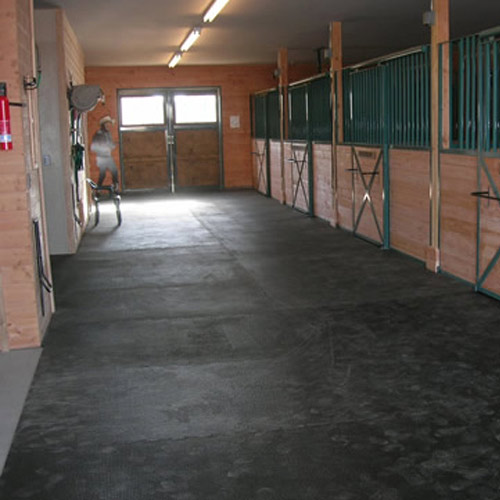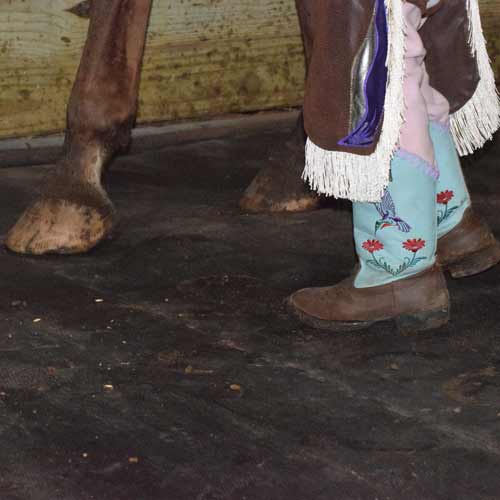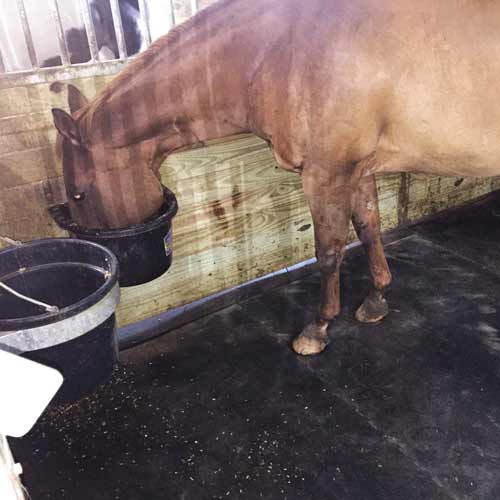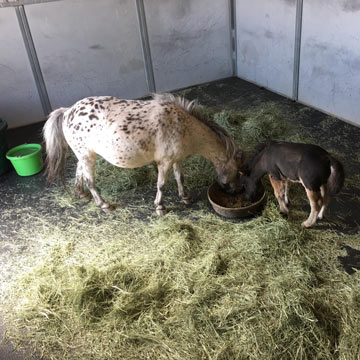Do horse stall mats replace the need for horse stall bedding?
Related Product: Horse Stall Mats Kit Cobblestone 3/4 Inch x 12x12 Ft.
Since stall mats are forgiving yet durable, they can withstand plenty of equine traffic while still being a favored safety feature in stables both large and small. If you head to any serious boarding or training facility, you're sure to see that every stall is matted - and with good reason.
But do stall mats need to be used with shavings or other bedding?
Generally speaking, yes. Horse stall mats offer some shock absorption and are much more forgiving than a concrete floor, but they're not intended to be the only source of cushion for a stalled horse. Generally you'll need to add a layer of shavings, straw, or other bedding over the mats to create a comfortable space for your horse.
Why You Need to Bed a Stall
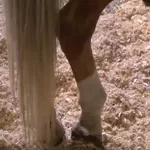 The bedding in your horse's stall serves a number of different purposes. It helps to cushion your horse against the firmer floor. This is particularly important for horses who spend long periods of time in their stalls. Your horse is more likely to lie down on a soft surface, and a proper layer of bedding can encourage your horse to get the rest that he needs. If bedding is inadequate, you may see a horse start to develop hock sores and other rubs (even with rubber horse stall flooring in place).
The bedding in your horse's stall serves a number of different purposes. It helps to cushion your horse against the firmer floor. This is particularly important for horses who spend long periods of time in their stalls. Your horse is more likely to lie down on a soft surface, and a proper layer of bedding can encourage your horse to get the rest that he needs. If bedding is inadequate, you may see a horse start to develop hock sores and other rubs (even with rubber horse stall flooring in place).
Bedding also helps to absorb urine, so your horse doesn't end up standing or lying in a puddle. Horse urine can cause skin irritation and respiratory issues if allowed to build up. Bedding helps to absorb it so that you can thoroughly remove it when you clean the stall.
While you do need to use bedding with stall mats, rubber matting means you can usually use less shavings or bedding than you could if the mats weren't in place. If you were working with a hard stall floor, like concrete, then you would need to bed particularly heavily to minimize the fatigue and pain that standing on such a hard surface could cause.
With stall mats in place, the amount of bedding that you need to use is reduced, which means that you'll save not only on the cost of bedding, but in labor, too, since cleaning the stall will be easier. Plus, if you pay to have your manure pile hauled away, less bedding will mean a smaller manure pile and additional monetary savings.
Stall mats can also help to keep your bedding clean, so while you do go through bedding, you'll go through less. Horses can't dig down into a stall base with mats in place, so there's no mixing of dirt or sand with the bedding. The bedding will stay light and clean, so you can clean stalls faster while wasting less bedding.
Situations Where You Might Not Need Bedding
There are a few situations where you might decide to forego pairing bedding with rubber stall mats: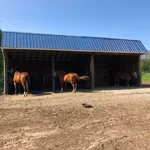 - If you use mats as horse stall flooring for a run-in shed in a paddock, bedding might not be necessary. Horses tend to spend less time in a run-in shed than they do outside, and you'll usually find horses lying down to nap in the pasture, so extra cushion
- If you use mats as horse stall flooring for a run-in shed in a paddock, bedding might not be necessary. Horses tend to spend less time in a run-in shed than they do outside, and you'll usually find horses lying down to nap in the pasture, so extra cushion
 - If your horse only comes into his stall to eat, and is then turned out again, it may be just fine to forego using bedding in your stalls.
- If your horse only comes into his stall to eat, and is then turned out again, it may be just fine to forego using bedding in your stalls.
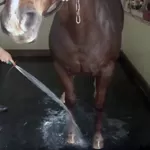 - When you use stall mats in other areas of your barn, like grooming stalls, then bedding isn't needed.
- When you use stall mats in other areas of your barn, like grooming stalls, then bedding isn't needed.
- Putting stall mats in your horse trailer? The option of whether or not to use bedding is up to you. Some horse owners always use bedding when hauling, thinking that it can help to provide additional traction. Other horse owners think the opposite, preferring as much hoof-to-mat contact as possible for maximized traction. It's a personal preference, so do what you're most comfortable with.
Additional Benefits of Using Stall Mats
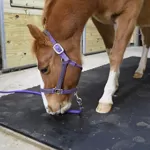 Don't let the fact that you still need bedding with horse mats dissuade you from using them. Here are just a few of the benefits of using rubber mats for horse stalls:
Don't let the fact that you still need bedding with horse mats dissuade you from using them. Here are just a few of the benefits of using rubber mats for horse stalls:
- Horse stall mats help to prevent horses from digging in their stalls. Your bedding stays cleaner, your stalls are easier to clean, and there's less maintenance required for your stall floor.
- Barn mats help to prevent the cold of a concrete subfloor from spreading up to your horse.
- Stall mats can help to increase your horse's comfort, especially when you're dealing with a hard subfloor, like concrete.
- The safe, forgiving surface of a mat helps you to avoid vet bills, especially if a horse falls or slips in his stall.
- Durable stall mat construction means that you'll get years of use, convenience, monetary savings, and time savings out of these stable mats.
Horse Mats: A Big Payoff
 In fact, horse stall mats will more than pay for themselves over time. Let's take a look at the financials. Here's what rubber horse stall matting could do for a 24-stall professional training and boarding facility.
In fact, horse stall mats will more than pay for themselves over time. Let's take a look at the financials. Here's what rubber horse stall matting could do for a 24-stall professional training and boarding facility.
Without stall mats:
- Horses are kept stalled for half the day and all night. Each 12x12 stall requires approximately 5 bags of shavings per week, at $6 per bag. Total weekly bedding cost: $720
- It takes three staff approximately 4 hours per day to clean the 24 stalls. The staff are each paid $12 per hour, so the weekly cost of stall cleaning is $1,008.
With stall mats:
- Stalls don't require as much bedding, and the bedding stays cleaner longer. Now each stall only needs 3 bags of shavings per week, bringing the total weekly bedding cost down to $504.
- The stalls are easier and faster to clean, with no sand or dirt mixed into the bedding and no holes in the base to repair. It takes staff just 3 hours to clean the stalls each day, bringing the weekly cost down to $756.
For such a facility, horse stall mats could result in a monthly savings of approximately $1,800. The initial investment of purchasing horse mats for all 24 stalls will be surpassed by the savings within just a few years. After that, the barn will continue to save.
Horse mats can mean big money for equine businesses, too. Clean, matted stalls are attractive, and can help to bring in business for boarding facilities.
It's expected that a quality boarding facility will have matted stalls; not having them might mean losing out on potential boarders, along with the subsequent income that they would bring in through lessons, showing fees, and more.
Not a professional facility? Not a problem. Stall mats are perfect for smaller backyard barns, too.
Here's what mats could mean for a 4-stall backyard barn.
Without stall mats:
- Horses are kept stalled at night, but are turned out during the day. Each 12x12 horse stall requires 3 bags of shavings per week, at $6.50 per bag. Total weekly bedding cost: $78
- It takes you about 1.5 hours per day to clean the stalls, so you spend 10.5 hours each week cleaning.
With stall mats:
- The bedding stays cleaner longer, so each stall only needs 2 bags of shavings per week. Total weekly bedding cost: $52.
- It's easier to clean the matted stalls, so the work goes faster. It only takes you 1 hour to clean the stalls each day, so you spend 7 hours each week cleaning
In this scenario, horse stall mats could save you $26 in bedding costs per month, or $312 per year. Plus, you'll gain 14 hours a month back. Just think of what you could do with that time, whether it's spending more time in the saddle, making repairs around the property, catching up on sleep, or spending time with your family.
These numbers are approximate, of course, and you may find that you save even more, especially if you're working with a particularly messy horse or if you have a number of horses who seem determined to dig holes to China in their stalls during the night. Plus, if you're bringing in new sand or filings to patch and fix holes in your horse's stall, you'll save on the time and money that you're spending to repair that damage.




